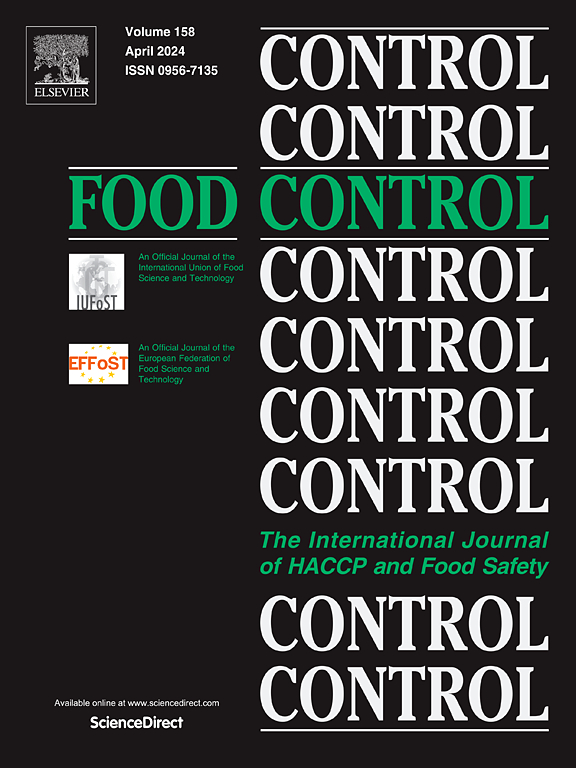Perillaldehyde controls citrus green mold by inhibiting the ribosome biogenesis of Penicillium digitatum and improving citrus disease resistance
IF 6.3
1区 农林科学
Q1 FOOD SCIENCE & TECHNOLOGY
引用次数: 0
Abstract
Perillaldehyde (PAE) is a green and safe active ingredient of natural plants. The inhibitory activity of PAE against the citrus postharvest pathogen Penicillium digitatum and its ability to control green mold were evaluated by in vitro and in vivo experiments. The results revealed that the minimum inhibitory concentration (MIC) and the minimum fungicidal concentration (MFC) of PAE against P. digitatum were 0.5 and 1 μL/mL, respectively. The results of conductivity, cell activity staining, and calcium fluoride white staining revealed that PAE damaged the membrane and cell wall integrity of P. digitatum. PAE promoted ROS accumulation in P. digitatum, as shown by 2′,7′-Dichlorofluorescein diacetate (DCHF-DA) staining, which may induce cell death. To further investigate the molecular regulatory network of PAE in P. digitatum, we performed an RNA-sequencing analysis. The results displayed that differentially expressed genes were significantly enriched in the biogenetic pathway of ribosomes, and all of these genes were downregulated, suggesting that PAE treatment interfered with ribosome biogenesis in P. digitatum and inhibited the normal life processes of cells. Furthermore, PAE treatment reduced the incidence and severity of citrus green mold, and the overall control effect of the PAE treatment group with 5 × MFC was greater than that with 10 × MFC. Therefore, we determined the activity of enzymes related to fruit disease resistance. The results revealed that PAE treatment significantly increased the activities of CAT, POD, and PAL in citrus. These findings demonstrate that PAE prevents green mold disease by increasing the activity of citrus disease-resistant enzymes.
紫苏醛通过抑制指状青霉核糖体的发生和提高柑橘的抗病性来防治柑橘绿霉病
紫苏醛(PAE)是一种绿色安全的天然植物活性成分。通过体外和体内实验,评价了PAE对柑橘采后病原菌指状青霉的抑制活性和对绿霉的控制能力。结果表明,PAE对digitatum的最小抑菌浓度(MIC)和最小杀真菌浓度(MFC)分别为0.5 μL/mL和1 μL/mL。电导率、细胞活性染色和氟化钙白染色结果显示,PAE破坏了指状地黄细胞膜和细胞壁的完整性。2 ',7 ' -双乙酸二氯荧光素(DCHF-DA)染色显示,PAE促进了指状假体中ROS的积累,可能导致细胞死亡。为了进一步研究马尾松PAE的分子调控网络,我们进行了rna测序分析。结果显示,核糖体生物发生途径中差异表达基因显著富集,且均下调表达,提示PAE处理干扰了指地黄核糖体的生物发生,抑制了细胞的正常生命过程。此外,PAE处理降低了柑橘绿霉的发病率和严重程度,5 × MFC PAE处理组的总体控制效果大于10 × MFC处理组。因此,我们确定了与果实抗病相关的酶的活性。结果表明,PAE处理显著提高了柑橘中CAT、POD和PAL的活性。这些发现表明,PAE通过增加柑橘抗病酶的活性来预防绿霉病。
本文章由计算机程序翻译,如有差异,请以英文原文为准。
求助全文
约1分钟内获得全文
求助全文
来源期刊

Food Control
工程技术-食品科技
CiteScore
12.20
自引率
6.70%
发文量
758
审稿时长
33 days
期刊介绍:
Food Control is an international journal that provides essential information for those involved in food safety and process control.
Food Control covers the below areas that relate to food process control or to food safety of human foods:
• Microbial food safety and antimicrobial systems
• Mycotoxins
• Hazard analysis, HACCP and food safety objectives
• Risk assessment, including microbial and chemical hazards
• Quality assurance
• Good manufacturing practices
• Food process systems design and control
• Food Packaging technology and materials in contact with foods
• Rapid methods of analysis and detection, including sensor technology
• Codes of practice, legislation and international harmonization
• Consumer issues
• Education, training and research needs.
The scope of Food Control is comprehensive and includes original research papers, authoritative reviews, short communications, comment articles that report on new developments in food control, and position papers.
 求助内容:
求助内容: 应助结果提醒方式:
应助结果提醒方式:


